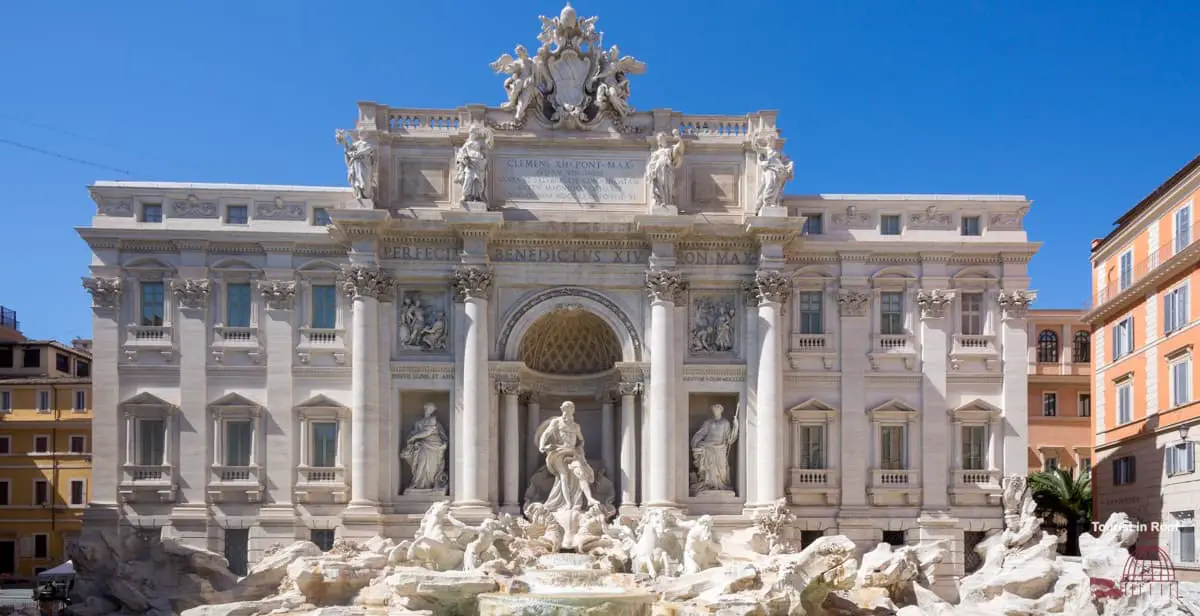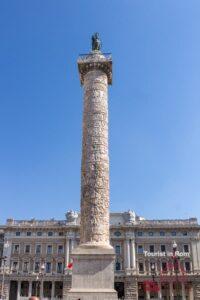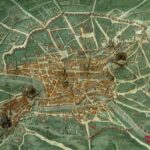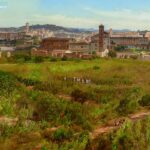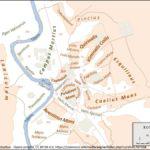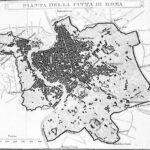Discover the historical heart of Rome with a delightful mix of history, gastronomy, and captivating sights in the downtown area.
Rome’s centro storico offers countless opportunities to create lasting memories! Whether you’re shopping at the Spanish Steps, exploring landmarks such as the Pantheon and the Trevi Fountain, dining in the Ghetto, visiting historic churches and relics, or enjoying the vibrant nightlife of Campo de’ Fiori, the heart of Rome offers something for every taste and interest.
Inhalt
Contents
Indice
Important sights
Where is Rome’s city center: The historic center of Rome stretches from the Capitol to the walls of Piazza del Popolo. It is bordered on one side by the Tiber River and on the other by the Pincio and Quirinal Hills. In ancient times the area, then known as Campus Martius, the Field of Mars, was used for entertainment such as sports, baths, concerts and theater. Over the centuries, ancient buildings were demolished and rebuilt. This created the mix that makes the Rome city center so unique and interesting.
Embark on a leisurely walk of approximately 4 kilometers, allowing about three hours to explore seven enchanting places that are sure to capture your heart.
Rome City Center: The Ghetto
The Ghetto was created in 1555 by order of Pope Paul IV, who decreed that Jews could only live in the Ghetto. It is located between the Tiber River and the Capitoline Hill and is home to the prominent synagogue.
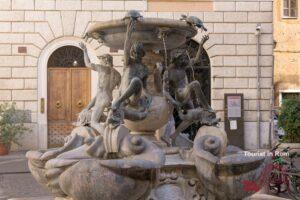
It stretches from the Theatre of Marcellus to Via Arenula and from the Portico of Octavia to the Turtle Fountain in Piazza Mattei. You will be amazed by the picturesque alleys and the good Roman cuisine. Specialties include fried artichokes – Carciofi alla Giudia – and the traditional Roman fish soup – Zuppa di pesce. Offal, oxtail and anything else that is left over from the slaughter are also part of the delicious Roman cuisine.
Rome City Center: Campo de’ Fiori
On your way to Campo de’ Fiori, you will pass by several street eateries in Via dei Giubbonari, such as the elegant Roscioli or the rustic Filettaro near the church of Santa Barbara, where you can get beer and wine from the barrel to go with your fried fish.
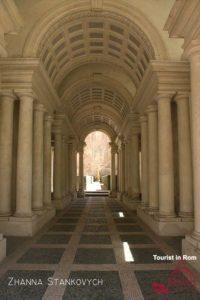
Walk along Via dell’Arco del Monte opposite Santa Barbara and then turn right into Via Capo di Ferro. You will arrive at Palazzo Spada, a building that houses the Council of State and a museum. From the courtyard, which is open to the public except on Tuesdays, you can admire through a window the “secret garden” that is part of the museum. Here you will find a Baroque optical illusion: the portico built by Borromini for Cardinal Bernardino Spada in 1653. Although the colonnade appears to be about 35 meters long, its actual length is only 8.82 meters. This makes the statue of the Roman warrior at the end of the colonnade appear much larger than it really is.
The path continues to Piazza Farnese with the French embassy palace of the same name. Through the windows you can admire the richly decorated ceiling of the hall on the first floor. Turn right and continue to Campo de’ Fiori.
Campo de’ Fiori is famous for its market and infamous as a place of execution. In the middle of the square is the statue of Giordano Bruno, a monk who was burned at the stake in 1600 for his thoughts on the universe and infinity. In the evening, the square and the surrounding bars are popular with young people and students from all over the world.
From Campo de’ Fiori, you can either walk directly to Piazza Navona or follow the ancient alleys that pilgrims used on their way to Castel Sant’Angelo and St. Peter’s Basilica.
Rome City Center: Piazza Navona
Piazza Navona still shows the shape of Domitian’s stadium, where tens of thousands of spectators could watch the competitions. Today’s buildings around the square were built on the ancient stands. The remains of the stadium can be visited underground.
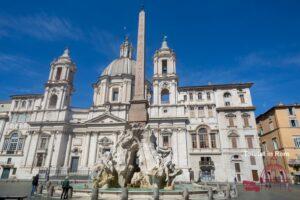
The story of the rival architects Bernini, who built the Fountain of the Four Rivers, and Borromini, who built the Church of Sant’Agnese in Agone, is intertwined around the square. The figures on the fountain represent the Danube, the Nile, the Ganges and the Rio della Plata, which were known at the time. Although the fountain was built before the church, the Rio della Plata already looks at the church with horror. On the façade of the church you can see the statue of St. Agnes, who seems to make sure that the church does not fall over. Learn more about Piazza Navona
Rome City Center: Pantheon
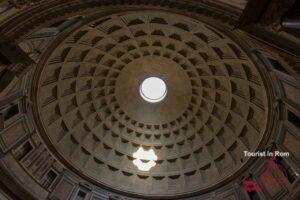
The Pantheon, one of the few intact buildings of antiquity, dates back to 27 B.C. After fires, it was rebuilt in the years 120-124. In the 7th century it was consecrated as a basilica with the name Santa Maria ad Martyres.
The dome has a larger diameter than that of St. Peter’s and a central opening that offers a view of the sky. In the floor of the Pantheon are drains through which rainwater can run off. When it rains, the Pantheon offers a very special spectacle. Learn more about the Pantheon
Rome City Center: Trevi Fountain
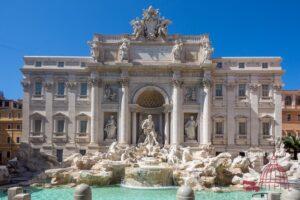
The sound of water can be heard long before the sight of the Trevi Fountain. The Trevi Fountain has a construction history of over a hundred years. Lack of money led to many interruptions. It was inaugurated three times, the last time in 1762.
The theme of the fountain is the ocean. If you throw a coin over your shoulder into the fountain, you are sure to return to Rome. Learn more about the Trevi Fountain
Rome City Center: Spanish Steps
The noble Spanish Steps were financed by the French. Their real name is Scalinata di Trinità dei Monti. An impassable steep slope was transformed into a world-famous work of art. The English name refers to the Spanish square below, in front of the mighty Spanish Embassy to the Holy See. In the past, this square was extraterritorial and those fleeing from the gendarmes of the Papal States sought asylum here.
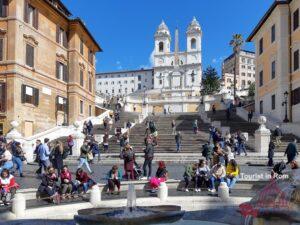
There are 135 steps from the Spanish Square to the French Church of Trinità dei Monti on the Pincio. The staircase was inaugurated in 1725. The Obelisk was built in 1789.
In 2015-2016, the staircase was restored with the help of the Bulgari fashion house, and traces of food residue and chewing gum stains were painstakingly removed. The City of Rome now hopes that both locals and visitors will behave in a civilized manner to ensure continued free access to the staircase. Learn more about the Spanish Steps
Rome City Center: Pincio
The steep Pincio hill stretches east of the city center and offers a variety of beautiful views. In the Pincio Park you can rent bicycles and there are pedal cars for the children. The terrace of the Pincio is a popular place to look at Piazza del Popolo.
Experience the center of Rome on foot
Rome’s center is easily explored on foot. A guided tour in an electric golf cart is also very convenient and environmentally friendly.
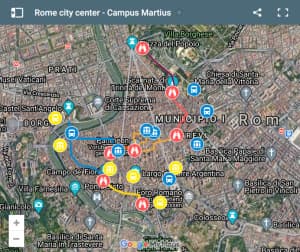
In our map you can see the routes that we have described here above.
From the Pantheon to the Trevi Fountain you can choose between different variants:
- The ice-cream parlours route: You have the choice between the ice cream parlor della Palma in via San Maddalena with 150 flavors and Giolitti, a historic coffeehouse in Rome. An ice cream cup buried under cream mountains at Giolitti replaces a lunch.
- The Harry Potter Route: It leads past the Caffè Tazza d’Oro to the magic shop Eclectica, where already Harry Potter did the shopping.
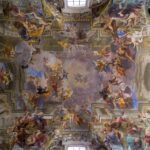 The Jesuits route: The church of Sant’Ignazio bears the name of the founder of the order. She is known for her perspective ceiling painting. Among other things, there is a painted dome. Opposite is the cozy Restaurant with pizzeria da Sabatino, where you can eat very comfortably on the square. We continue through Via de ‘Burrò to Piazza di Pietra with the Temple of Hadrian.
The Jesuits route: The church of Sant’Ignazio bears the name of the founder of the order. She is known for her perspective ceiling painting. Among other things, there is a painted dome. Opposite is the cozy Restaurant with pizzeria da Sabatino, where you can eat very comfortably on the square. We continue through Via de ‘Burrò to Piazza di Pietra with the Temple of Hadrian.
On the way from the Trevi Fountain to the Spanish Steps, you can make a short detour to the luxury department store La Rinascente on Via del Tritone. There you will find an impressive roof terrace with a wonderful view. In the basement you can also admire the ancient aqueduct Acqua Virgo, which supplies water to the Campus Martius, the Trevi Fountain and the Four Rivers Fountain in Piazza Navona.
How to get there
Hotels in the center of Rome are usually the best choice. They put you right in the heart of the action and allow you to make the most of your stay. Read more about Hotels in Rome.
The subway line Metro A touches the center on the edge of the Pincio hill with the stations Barberini, Spagna and Flaminio (Piazza del Popolo).
For the ghetto: Tram 8 (Arenula / Cairoli), Bus 23, 280 (near the Tiber), Bus 30, 44, 51, 63, 81, 83, 85, 87, 118, 160, 170, 628, 715, 716. 781, H (Teatro Marcello)
Campo de’ Fiori / Piazza Navona: Bus 46, 62, 64, 916
Piazza Navona / Pantheon (Rinascimento): 30, 70, 81, 87, 492, 628
Via del Corso: 62, 63, 83, 85, 119, 160, 492
Piazza del Popolo (Flaminio): Tram 2, Bus 61, 89, 160, 490, 495, 590, 640
The center of power
Downtown Rome is very safe. Parliamentarians, senators and ministers stroll through the city center in their free time, go shopping and spend the evenings with their visitors in the numerous good restaurants and wine bars.
The seat of government
The seat of the head of government is Palazzo Chigi.
It is on the corner of Piazza Colonna and Via del Corso. In front of the palace there is an ancient column, la Colonna di Marco Aurelio. It was built in memory of the emperor Marcus Aurelius between the years 176 and 192.
The Parliament
To the left of Palazzo Chigi is the Palazzo Montecitorio, built by Bernini, the seat of the Italian Parliament, the Camera dei deputati. In the square is the obelisk of Psammetich II, which was erected by Augustus in 10 BC. It was brought from Heliopolis to Rome and is used here as a sundial. It should be around 2,600 years old.
The number of parliamentarians is 630 until the end of the 18th legislature and will then be reduced to 400 due to an electoral reform from 2020. The natural end of the legislative period is in 2023.
The Senate
On Corso del Rinascimento is Palazzo Madama, the palace of the Italian Senate. The palace goes back to Giovanni de Medici, who later became Pope Leo X.
There are 315 elected senators, which will be reduced to 200 in the next legislature. In addition, there are particularly deserving citizens as senators for life.
Active in Rome
Many Romans and tourists visiting Rome like to start the day with a morning jog. Whether it’s running along the Tiber or getting some oxygen in one of the villas, Rome has plenty of options for sports enthusiasts. There are also many beautiful routes for cyclists, and among the seven hills, monuments and ancient relics, there are many interesting paths for walking around the city.
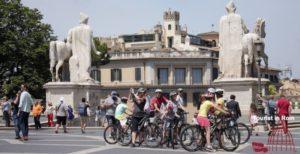
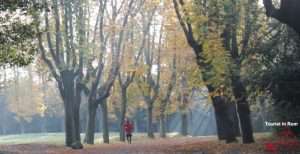
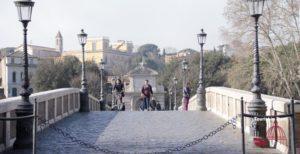
Gastronomy
You can eat really good food in the center of Rome. You can find information and tips in our Eating in Rome section.
There are many good restaurants along our route from the Ghetto to the Pincio. Here is a small selection:
Roman cuisine can be found everywhere, especially in the Ghetto. Armando al Pantheon is famous, but you have to book a month in advance. You also need to book well in advance at Alfredo alla Scrofa for the famous Fettucine Alfredo.
Many restaurants in Rome offer healthy organic cuisine as well as vegetarian and vegan specialties. Pioneers on our route include Ginger and two Vivi Bistrot restaurants at Piazza Navona in the Museo di Roma and in the La Rinascente department store in via del Tritone.
To get to know the area around Rome, you have to taste the products. The Enoteca Regionale ![]() offers only local products.
offers only local products.
Street food can be found all over Rome, but some places are part of the city’s history. These include Roscioli Pizza ![]() , Dar Filettaro (fried fish)
, Dar Filettaro (fried fish) ![]() and the Forno Campo de’ Fiori
and the Forno Campo de’ Fiori ![]()
In Rome you can find many restaurants with a long tradition. They are mentioned in every guidebook and besieged by tourists. Nevertheless, they try to preserve tradition and often offer the same products for more than a hundred years. These include the Sant’Eustachio in the square of the same name ![]() , the Antico Caffè Greco
, the Antico Caffè Greco ![]() in Via dei Condotti and the Babington’s tea house
in Via dei Condotti and the Babington’s tea house ![]() right next to the Spanish Steps.
right next to the Spanish Steps.
UNESCO world heritage
The area within the Aurelian walls and the Basilica of St. Paul Outside the Walls is part of the UNESCO World Heritage List. UNESCO has designated the entire area with an area of 14.25 km² as the “historic center of Rome”.
That is pretty high. After all, until the 19th century, artichokes and vegetables were grown on most of the land within the walls, and sheep grazed among the ruins.
The painter Friedrich Loos painted a 360° panorama picture on Villa Celimontana in 1850, which was digitized by the Alte Nationalgalerie Berlin on the occasion of an exhibition. The view of the city in the direction of the Colosseum – at the bottom of the picture – shows what Rome looked like at the time.
The historical center can therefore be delimited very well with the area around Via del Corso between the Tiber, Capitol, Quirinal and Pincio. In contrast, the antique center is located in the archaeological area of the Colosseum Park.
History
Today’s center of Rome is in the area of the ancient Field of Mars. Since the founding of Rome, the area was dedicated to the god of war Mars, but was outside the city.
In ancient times, the center was located in the archaeological area around the Colosseum and was delimited by the Capitol Hill.
The field of Mars stretched from today’s ghetto along the Tiber to Piazza del Popolo. There it was bounded by the hill of Pincius and further south by the Quirinal hill.
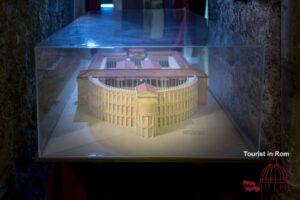
The first monumental building was in 55 BC the theater of Pompey. It ranged from Campo de’ Fiori to today’s cat colony on Largo di Torre Argentina. Gaius Julius Caesar was murdered here and Emperor Augustus had the largest latrine in Rome built here to condemn the place forever.
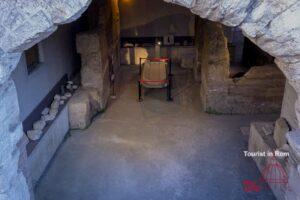
At the time of Augustus the field of Mars came to the urban area and it was mainly used as a sports and cultural center. The result was an athletics stadium, the stadium of Domitian, which can still be visited today under Piazza Navona.
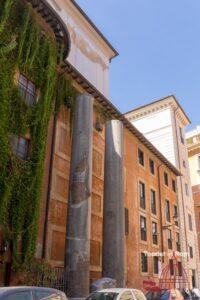
Next to it were an auditorium, the thermal baths of Nero and the Pantheon. Further north is the Ara Pacis and the Mausoleum of Augustus, to the east the Temple of Hadrian at the Piazza di Pietra. More relics can be found throughout the area. It was supplied with water from the Acqua Vergine aqueduct.
After the end of the Western Roman Empire, an eventful history began for Rome and the population fell sharply at times. Popes, princes, wealthy families and immigrant merchants built palaces and monuments on the Field of Mars. The medieval conditions in Rome partly ended with the occupation of Rome by Napoleon in 1797 and finally with the end of the Papal States in 1870.
Il Tridente
Since ancient times, the so-called “trident” has had a special meaning. The central Via del Corso is the last piece of the ancient Via Flaminia that connects Rome with Umbria and Rimini until today. From the city gate at Piazza del Popolo to Piazza Venezia it was called Via Lata. In the 16th century, two streets were added to the right and to the left, starting straight as an arrow from Piazza del Popolo. Thus was born the “trident” – il Tridente.
To the left of the Corso, Via del Babuino goes to the Spanish Steps and on to the Quirinal, to the right Via di Ripetta and then Via della Scrofa to the back of the Senate building. From there, turn right to Piazza Navona and left to the Pantheon.
The “Trident” is a particularly low-traffic area with many stores and restaurants. In this area, fashion-conscious shoppers will find everything their hearts desire.
Rome city center in brief
The historical center belongs to the 1st district of Rome ( Municipio I ). As of December 31, 2020, 23,693 inhabitants were counted, the area is 3.19 km² (source Wikipedia.it) The 1st district includes the entire area within the Aurelian walls and the districts of Trastevere, Prati, Della Vittoria and Eroi.
The numbers for the area within the walls are:
| Quarter | Area km² | Residents |
| Centro storico | 3.19 | 23,693 |
| Aventino | 1.56 | 8,251 |
| Testaccio | 0.65 | 7,671 |
| Esquilino | 3.09 | 33,017 |
| XX Settembre | 1.4 | 8,796 |
| Celio | 0.68 | 3,857 |
| Zona archeologica | 1.91 | 763 |
| Total | 12.48 | 86,048 |
FAQ
We receive many questions about the city center of Rome. Here we would like to answer some of the questions we are asked most often.
How big is the historic center of Rome
The Centro Storico has an area of 3.19 km² with nearly 24,000 inhabitants. It is located in the area around Via del Corso between the Tiber and the hills of Capitoline, Quirinal and Pincio, and ends at the city walls in Piazza del Popolo.
How do I get from the airport to the Rome city center by cab?
By cab there is a fixed price from the airports to the center of Rome. The fixed price is valid around the clock and is €50 from Fiumicino airport and €31 from Ciampino airport.
How do I get from Ciampino airport to Rome city center by bus?
From Ciampino there are shuttle buses to Termini Station and from there you can continue by bus or metro to Rome’s historic center. There are city bus lines to metro lines A and B. Ciampino Airport Information
How do I get from Fiumicino airport to the center cheaply?
From Fiumicino, the Leonardo Express fast train and shuttle buses go to Termini Station. From there you can continue to Rome’s center by bus or metro. Take the FL1 regional train to Trastevere and from there continue to the city center by bus or streetcar. Information about Fiumicino Airport
Can I go to the Rome city center by car?
The city center belongs to the so-called ZTL, zone with limited traffic. You can drive into the ZTL without special permission only at night, on Saturday mornings and on Sundays. The entrance is controlled by cameras. If you see the writing “Varco attivo”, you are not allowed to enter without permission.
As a hotel guest, can I drive my car into the city center?
Special permits are available for hotel guests. You will need to contact your hotel for this. However, it is very difficult to find a parking space in the city center.
Can I drive a hybrid vehicle or an electric car in Rome city center?
Hybrid cars are subject to the same rules as internal combustion cars regarding driving in the city center. However, they can park for free in the parking spaces marked in blue if the license plate has been previously registered with the city police. Electric cars can drive into the city center and park for free if the license plate has been previously registered with the city police. Online access Romamobilità
Can I, as a person with a disability, drive my car to the city center?
Persons with disabilities can register the license plate of their car with the Rome Municipal Police to enter the ZTL. The registration is done through legally certified email addresses. Your embassy can assist you with the procedure.
Is it dangerous in the center of Rome?
The biggest danger in the historic center of Rome is pickpocketing. If there are many people standing close together, you need to be careful. Also, you should not be approached by flying merchants. Otherwise, it is rather safe in Rome. Many parks are closed at night and it is generally not a good idea to visit the parks at night. For more information, read our article on safety in Rome.
Do you have any questions? Write us here below in the comments.
What to do in Rome
Looking for ideas on what to do in Rome? We have prepared information and suggestions for interesting places in Rome. Have fun reading what we have prepared for you.



